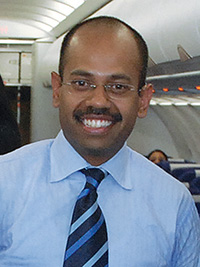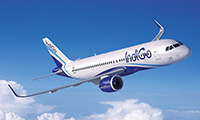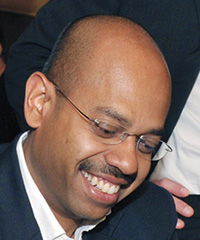Cover Story
MAN WITH A MANTRA
At only eight years old, budget carrier, IndiGo, is the country’s biggest airline by market share. Its mantra is low-cost does not mean low quality, Aditya Ghosh, the carrier’s president is a man determined to deliver the Indian travel experience differently.
November 1st 2014
At 39, former corporate lawyer and IndiGo president, Aditya Ghosh, knows what he wants from his airline - operational discipline and staff with the right attitude. Read More »
 |
| Adyita Ghosh president of IndiGo Airlines: Low-cost does not mean low quality |
Ghosh takes attitude so seriously that he personally interviews new employees, including drivers and mechanics. “I try to judge if there is a desire to chase the dream. People can’t get motivated by a manual,” said Ghosh, who prefers casual shirts to suits and knew very little about airlines when he was appointed president in late 2008, aged 32.
Under Ghosh and founding president, Bruce Ashby, IndiGo has built a reputation for cheery, no thrills service and 99% plus punctuality. The latter factor is particularly appreciated by the airline’s corporate flyers, who work in affluent Gurgaon, IndiGo’s home city 32 kilometres south of Delhi.
In a recent interview, Ghosh said keeping focused on the business of delivering quality service with good fares is IndiGo’s mantra. And it has worked. Last March, Indigo became India’s largest airline, with a market share of 32.6%. “I often marvel at what we achieve against all odds. But we want to deliver the Indian experience differently,” he said. Principally, this means that low-cost does not equal low quality at IndiGo. Passengers know what they will – and will not – get for their fare.
The carrier charges for food and passengers must pay extra for pre-assigned seats. There is no inflight entertainment, only distribution of an inflight shopping booklet. It offers web check-in and self-service ticket kiosks, express check-in for a fee and a unique service in India of a Braille Guide for visually, speech and sound impaired passengers.
Passengers also like the fact that IndiGo’s fleet has an average age of 2.9 years and that it phases out aircraft after six years of flying.
Co-founded by the group managing director of InterGlobe Enterprises, billionaire Rahul Bhatia (52.1%) and a former CEO of U.S. Airways, Rakesh Gangwal (48%), IndiGo has defied its critics by setting new levels of growth as other Indian budget carriers have faltered, especially in the aftermath of the Global Financial Crisis.
Planning for the establishment of IndiGo began in 2004. By that time Ghosh, who had caught the corporate eye of Bhatia, was soon to become general counsel at InterGlobe. He came to be involved in the project because of his InterGlobe responsibilities. As an aviation novice, he said he benefited greatly from the knowledge of the startup team and Bhatia’s experience in the sector.
IndiGo was always going to be a domestic airline with only one aircraft type. In June 2005 Airbus got the call and 12 months later IndiGo received its launch A320 aircraft and commenced operations on August 4. Its mantra of hassle free, low-cost travel, had the perfect start up market in Gurgaon, a corporate satellite city where more than half of the Fortune 500 companies have offices.
 |
Its first flight was from Delhi to Imphal, in north western India, from its home hub at Indira Gandi International Airport outside Delhi. By the end of 2006, the fleet had expanded to six A320-20s. Nine more A320s arrived in 2007. In May that year, Ghosh joined the board of IndiGo. A little more than a year later, Ashby decided to accept an offer from SAMA Aviation to be its CEO and Ghosh become IndiGo’s president-designate. He took control of IndiGo in December 2008.
In 2009, after only a few months in the job Ghosh could report the carrier was making money. The key to its success, analysts agreed, is Bhatia’s almost fanatical cost-consciousness and Ghosh’s persistence in maintaining that disciple.
The new president pared costs by significantly increasing aircraft utilization, implementing the fastest turnarounds of any Indian carrier – just 30 minutes – and holding to a lean staff to aircraft ratio. The learning curve steepened, said Ghosh, a notoriously media shy family man, who said his mother never expected him to amount to anything.
To the outside world, Ghosh and the airline was a perfect corporate match. By 2012, less than four years after its launch, IndiGo was India’s third biggest airline. In the next 18 months it sailed past competitors to become India’s largest airline by passengers.
It operates 534 daily flights to 36 domestic and five international destinations with a fleet of 83 A320 family aircraft. It was voted one of the top 50 companies for employees to work for and the best company for staff in the transport industry. It has won several global industry awards and has recorded double digit growth for most of its eight-year life.
Nevertheless, IndiGo has not been immune to India’s sharp economic slowdown. In its latest year, ended March 31, net profit plunged by 60%, to $130 million. on revenues of $1.6 billion. But in a local industry that reported combined losses of $1.8 billion, the profit was a remarkable achievement. Rival SpiceJet lost a record $163 million and full-service airline, Jet Airways, was $670.8 million in the red, also a record deficit.
 |
| 'IndiGo has the fastest turnaround of any Indian airline – 30 minutes ' |
| Adyita Ghosh President IndiGo |
IndiGo has stayed financially aloft by “keeping costs structurally low”, Ghosh explained. For example, the airline stocks no hot food on board and has no loyalty program. Every expense has to be justified. “We keep asking ourselves: What other cost can we remove without losing a single customer? This is our religion, and it serves us well,” he said.
As for all these new planes, Ghosh says IndiGo will operate them wherever there is demand in the airline network. The carrier qualified to fly international services after completing a government requirement of operating for five years as a domestic carrier. It now flies to Bangkok, Singapore, Khatmandu, Dubai and Muscat, but it is cautious about longer haul routes.
Bhatia once said that “it might be sexy to see the IndiGo tail in Los Angeles, but we are doing well right here”. “We believe there is a lot more to be done in India. Our primary focus is the domestic market and will continue to be,” said Ghosh.
He holds to this view for the future of IndiGo because it is the world’s second largest nation by population yet only a tiny minority is airline flyers. “IndiGo will continue to expand its network to meet the requirements of both business and leisure travelers wherever they demand it, both in India and abroad,” he said in a recent interview.
“We have been blessed with many years of double digit growth – and once in a while there is a slow year. But India is a highly under-penetrated aircraft market with a burgeoning and productive population that needs to fly at affordable fares,” he said.
“We see huge potential in the Indian domestic market and with our Gross National Product (GDP) growing at the rate of 6% to 7% for the next decades, the growth of aviation in India is just starting.”
Growth projections and past successes aside, the news in mid-October that IndiGo had signed a Memorandum of Understanding (MoU) with Airbus for 250 A320neo family aircraft plus 100 options, impressed the market. If the MoU is converted to a purchase contract, it will be Airbus’s single largest order by number of aircraft, at a list price of US$25.6 billion. Airbus said it expected the deal to be finalized in 30 days.
The order follows IndiGo’s earlier commitments for 100 A320s and 180 A320neos. At the same time the latest fleet expansion was announced, IndiGo agreed to sublease 12 A320s from Singaporean LCC, Tigerair.
Analysts said the orders are a massive bet that India’s often chaotic airline market is eventually going to sort itself out and its potential will be realized. “The deal is a strong indicator of the long-term potential of the Indian civil aviation market,” said Amber Dubey, partner and India head of aerospace and defence at global consultancy KPMG.
Ghosh said at the MoU signing: “We have always maintained that air traffic penetration in the Indian market is lower than countries such as the Philippines and a lot more needs to be done to increase capacity.”
“There are a lot of growth opportunities locally. The number of aircraft in India is lower than in Brazil, China or Indonesia,” he said. Boeing forecasts India will require 1,290 aircraft by 2032 to cater for demand in the world’s second largest country.
Before Ghosh and his owners signed the MoU in October, IndiGo had an order book of 280. Of its original 100-plane order, placed in 2005, it has received 99. The final aircraft is due to arrive at the carrier this month.
Ghosh said: “We will start receiving the A320neos we ordered in 2011 from next October. In the following three months we will receive six planes. We have converted 30 A320s from the 2011 order to A320neos so all 180 planes will be A320neos. We are also taking 12 A320 planes on lease from Tigerair with deliveries to begin this month.
“We finished our first 100-plane order two years early. According to the original plan, the deliveries were to continue until 2016. We might speed up induction, but it depends on market growth.
“Airplanes from the latest order will start in 2018. Those inductions will overlap with deliveries of the earlier order for 180 planes. Apart from the confirmed orders, we have rights to purchase another 100 planes from Airbus. Planning in advance allows us to plan better. We have always done business that way. We ordered 100 planes in 2005 and started operations a year later. Our profitability also allows us to plan for the next five years.”
There is speculation in India that IndiGo is preparing for an initial public offering (IPO) next year. Ghosh won’t comment on the subject nor will he talk about valuations of the airline, which range from US$1.5 billion to US$3 billion.
He said there is no urgent need for IndiGo to raise cash because the airline recently secured a $2.6 billion loan from the Industrial & Commercial Bank of China for 30 planes – in a deal that was another first for India.
One thing is certain: making money in India’s highly competitive market yet alone maintaining the sort of income record of IndiGo is not easy – and there are more tests of the market to come. AirAsia India, a joint venture with India’s Tata Industries and Malaysia’s AirAsia Group, is flying in India, but only has one aircraft in operation so far. Another newcomer, Air Costa launched earlier this year.
As well, the Tata joint venture with Singapore Airlines, full service carrier, Vistara, will soon commence operations. It is reported that other entry level airlines have received government approval to fly.
How many of them will survive long-term is anyone’s guess. But IndiGo is determined to maintain its market leadership, despite its planned huge capacity increase. In October, in the details of Winter Schedules filed by all airlines with India’s aviation regulator, the DGCA (Directorate General of Civil Aviation), only two carriers will be operating more flights during the season, IndiGo and another budget carrier, GoAir. IndiGo will increase its schedule by 25% and GoAir by 12.6%. Rivals cutting services include SpiceJet (16.2%), and Jet Airways (8.6%) and Air India (2.6%).